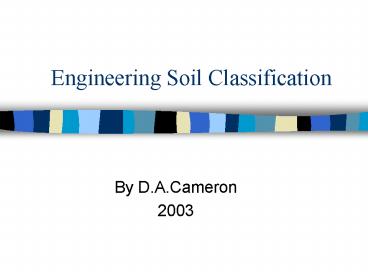Engineering Soil Classification PowerPoint PPT Presentation
1 / 40
Title: Engineering Soil Classification
1
Engineering Soil Classification
- By D.A.Cameron
- 2003
2
The Soil Phases
PHASE DIAGRAM
THE SOIL SYSTEM
AIR
WATER
SOIL SOLIDS
Air pockets
3
New Terms
Density, ?, rho and unit weight, ?,
gamma e.g. ?water ?w 1 t/m3 or 1 g/cc
? ?w ?w x g 9.81 kN/m3 Unit
weight of concrete about 25 kN/m3 Soil varies
between about 15 - 21 kN/m3
4
Other densities
- Soil dry density, ?d
- Particle density, ?s
Mass of soil/total volume
No air or water!
5
Introduction to soil terms, contd
- Particle densities range between 2.6 and 2.7 t/m3
- Moisture content, w
- - based on mass of water
- - gravimetric rather than volumetric
6
Moisture Content,
M Mw Ms
Ms
Mw
Ms
M Ms
105 oC
gravimetric
7
Moisture and Density
- Prove that
- Where w water content (not in !)
8
More soil terms.
- Void Ratio, e
- Degree of saturation, SR
9
VOID RATIO
V Vs Vw Va
Ma, Va
Void volume, Vv Vw Va
Mw, Vw
Ms, Vs
10
Soil Consistency
- DENSITY of granular soils
- loose, medium dense, dense,
- or very dense
- STRENGTH of fine-grained soils
- soft, firm, stiff or hard
11
SOIL CLASSIFICATION
- 1. Pedological
- - classification based on the development
- of a soil profile due to weathering
- e.g. Great Soil Groups
- Taylor, Thomson and Shepherd
- Bulletin 46, Dept. Mines, S.A., 1974,
12
(No Transcript)
13
RB9 - Taylor et al (1974)
14
Great Soil Groups
- Adelaide Map Shallow exploration
- map unit soil association
- dominant soil types
- e.g. RZ / TR or BS / TR / BE
- UNCERTAINTY IS EVIDENT!
15
2. Unified Soil Classification System (USCS)
- Based on...
- Particle size
- - gravel, sand, silt, clay fractions
- Particle size distribution
- - grading
- Plasticity
16
(No Transcript)
17
Defining Particle Sizes
Grain size (mm)
0.002
0.02
2.36
20
200
0.075
0.6
6.0
63
Basic soil type
F M C
F M C
CLAY
SILT
SAND
GRAVEL
COBBLES BOULDERS
Fine-grained soil
Coarse-grained soil
18
Sieve Analysis - Coarse Soils
Uniform soils (P)
Silt (M)
Gap graded (P)
Gravel (G)
mm
Well graded (W)
n
19
Sieve Analysis
Uniform size range
deficient here
20
Particle Size Distribution Terms
UNIFORM SIZES P
GOOD MIX OF SIZES W
MISSING SIZE RANGES P
21
Defining equations
- The Uniformity Coefficient,
- Cu D60/D10 a gradient!
- If Cu ? ?5 ? uniform soil, P
- If Cu gt ?5 ? well-graded soil, W
- 4 for gravel and 6 for sand (AS1726)
22
Fine-grained Soils
- Too fine for sieving
- Sedimentation and/or laser equipment?
- Even then, sizes say nothing about clay
mineralogy and potential soil behaviour! - ?Fine-grained soils are defined by how plastic
they are
23
Symbols for Fine Grained Soils
24
Consistency Limits of Fine Soils
- Defining water contents
- 1. LIQUID PHASE
- - fluid,low shear resistance
- 2. PLASTIC PHASE
- - easily moulded
- 3. SOLID PHASE
- - strong, resists deformation
25
ATTERBERG LIMITS
Plastic Index or PI
solid
liquid
The plastic zone
PL
LL
Max.
Moisture content
0
26
Soil drying
27
Atterberg Limit Tests
- PLASTIC LIMIT
- - by rolling soil into threads
- - m.c. at which soil breaks at a 3 mm thread
the plastic limit - LIQUID LIMIT
- - basically the m.c. at which the soil can
fairly readily be sheared
28
Fall cone apparatus
Casagrande equipment
29
Casagrande Liquid Limit
1.
2.
3.
4.
Gap closed
30
The Plasticity Chart
PLASTIC INDEX
LL 75 PL 32
LIQUID LIMIT ()
31
Linear Shrinkage Test
- Change in length of half a cylinder prepared to
LL and oven-dried - Basically provides volume change of a remoulded
soil over - ?w plastic index
- e.g. Lo 250 mm ?L 25 mm
- ?LS 10
32
Field Tests of the USCSfor fine-grained soils
- Dry strength
- relative strength of a dry ball of soil
- prepared at PL
- Toughness
- - near PL when remoulded
- Dilatancy
- - volume change upon shearing
- - prepared at LL
33
TOUGHNESS how tough is it to remould?
Plasticity?
34
NOT SO TOUGH
35
Dilatancy (field test)
- Discard coarse material
- and wet the remainder
- Form a pat in your cupped hand
- Tap the back of your hand until water rises to
surface - (surface sheen)
- Stretch palm of hand
36
DILATANCY - Step 1
Water to the surface
37
DILATANCY - Step 2
Opening the hand shears the soil coarser soil
will dilate
38
Dilation increase in volume
39
Classification of Mixed Soils
- Wet sieve on 0.075 mm sieve
- gt 50 retained? coarse
- Sieve on 2.36 mm sieve
- lt 50 retained? Sand
- Sieve for fines
- lt 5 SP or SW (fines insignificant)
- gt12 SC or SM (plasticity?)
40
SUMMARY
- Soil classification for engineering purposes is
based on - 1. Fundamental particle sizes
- AND
- 2. Particle size distributions
- OR
- 3. Soil plasticity
- (LL, PI, LS or field tests)

